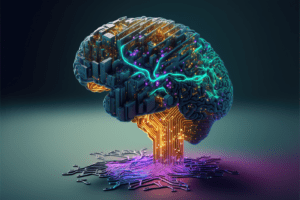What is Generative AI ? Top Emerging Technology !

Generative AI is a type of artificial intelligence that focuses on generating data or content, such as text, images, audio, or even other types of data, like music or video. It is a subset of AI that uses algorithms and models to create new information rather than simply processing or analyzing existing data. Generative AI is a rapidly evolving field with many applications, including natural language generation, image synthesis, creative content generation, and more.
The fundamental working principle of generative AI typically involves the use of neural networks, especially a class of models called generative models.
Let’s dig in more detail on how generative AI works:
1). Data Collection: To train a generative AI model, a large dataset of examples in the desired domain is collected. For example, if you want to generate text, you would gather a large text corpus. If you want to generate images, you’d gather a dataset of images.
2). Model Training: The collected dataset is used to train a generative model. One of the most popular types of generative models is the Generative Adversarial Network (GAN) and the Variational Autoencoder (VAE). These models consist of neural networks that learn to represent and generate data.
3). Sampling and Generation: Once the generative model is trained, it can be used to generate new data samples. For instance, in the case of text generation, you can provide an initial seed or context to the model, and it will generate text that follows the patterns it learned during training. Similarly, for image generation, you can input a random noise vector to the model, and it will generate an image based on the patterns it learned from the training data.
4). Evaluation and Refinement: The generated data is often evaluated for quality and coherence. Depending on the application, various metrics and human judgment may be used to assess the quality of the generated content. The model can be further refined or fine-tuned based on this feedback.
Why Generative AI is Top Emerging Technology ?
It is considered one of the top emerging technologies due to its transformative potential and the wide range of applications it offers across various industries. Several factors contribute to its prominence as a cutting-edge technology:

1). Creativity and Content Generation: Generative AI has the ability to generate creative and high-quality content, including text, images, music, and more. This has the potential to automate content creation tasks, reduce production costs, and open up new possibilities for creative endeavors.
2). Personalization: Generative AI can be used to personalize user experiences by tailoring content and recommendations to individual preferences. This is particularly valuable in fields like marketing, entertainment, and e-commerce.
3). Data Augmentation: In the realm of machine learning and data science, generative AI can be used to augment datasets, generate synthetic data for training models, and improve model performance. This is crucial for advancing the capabilities of AI systems.
4). Simulation and Training: Generative AI can create realistic simulations and training environments for applications in robotics, autonomous vehicles, healthcare, and more. This enables safe and cost-effective testing and training.
5). Efficiency and Automation: By automating content generation and design tasks, generative AI can increase efficiency and productivity in various industries, reducing the need for manual labor in creative and repetitive processes.
6). Art and Entertainment: Generative AI has made significant contributions to the fields of art, music, and entertainment by creating new forms of expression and enabling artists to explore novel creative avenues.
7). Scientific Discovery: In fields like drug discovery and materials science, generative AI can accelerate the search for novel compounds and materials, potentially leading to breakthroughs.
8). Personal Assistants and Chatbots: Generative AI powers chatbots and virtual assistants, improving customer service, answering queries, and enhancing user interactions.
9). Human-Machine Collaboration: Generative AI can serve as a tool for human creativity and problem-solving, facilitating collaboration between humans and machines.
10). Dynamic Advertisements: Marketers can use generative AI to create dynamic and personalized advertisements, increasing engagement and conversion rates.
11). Content Moderation: Generative AI can assist in content moderation by identifying and filtering out inappropriate or harmful content.
12). Disaster Preparedness and Response: AI-generated simulations and predictions can aid in disaster preparedness and response planning, helping to save lives and reduce damage.
Despite its many advantages, it also comes with ethical and societal challenges, such as the potential for misuse (e.g., deepfakes), bias in training data, and privacy concerns. Addressing these challenges and ensuring responsible AI development are critical aspects of harnessing the full potential of this emerging technology.
Generative AI continues to evolve rapidly, with ongoing research and development in the field. As it matures, it is likely to find even more applications and become an increasingly integral part of various industries and technological advancements.
